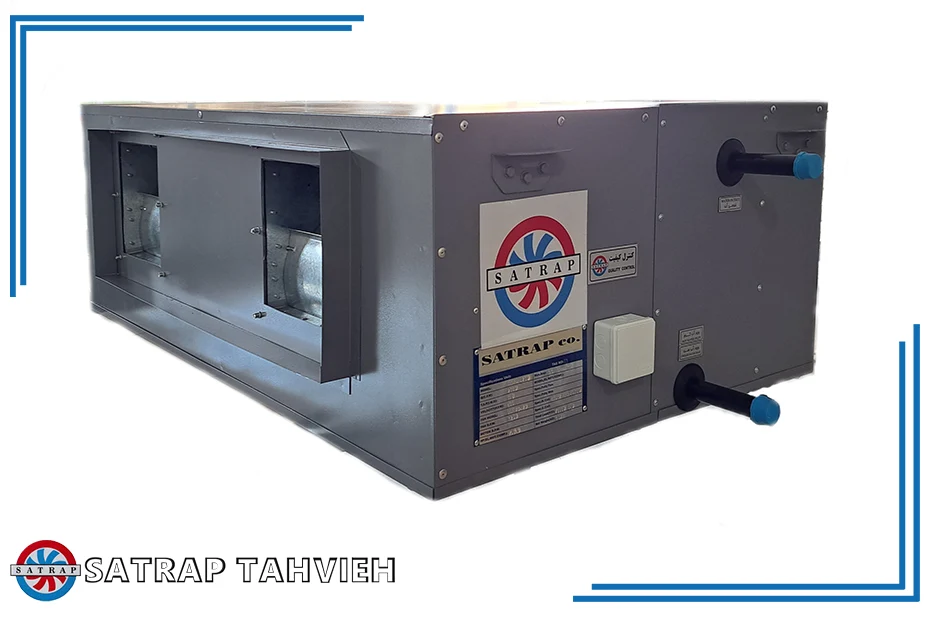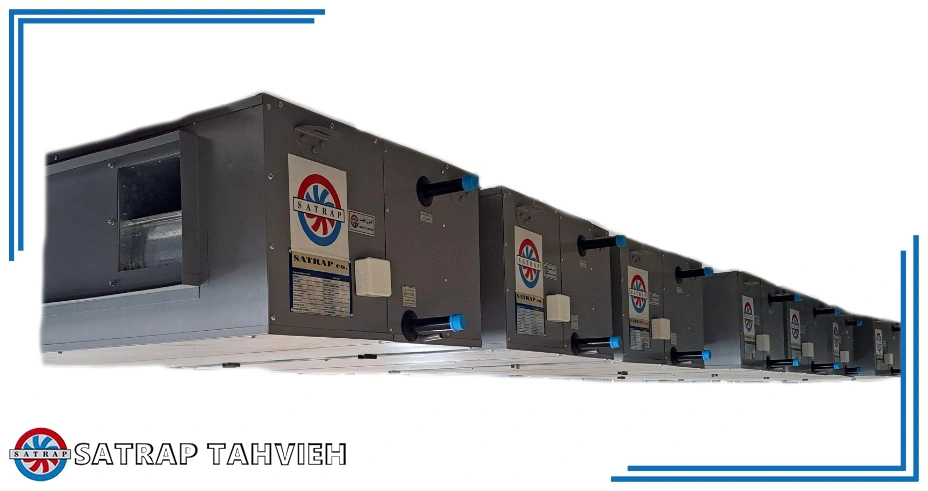Fan Coil Unit Repair and Service
The maintenance and service of fan coil units is essential to increase their lifespan and improve their performance. Fan coils are devices used in buildings for cooling, heating, and purifying air. These devices consist of various components, each of which requires regular maintenance and repair.
Maintenance actions for fan coils
Cleaning the filters
Fan coil filters should be cleaned regularly to prevent dust and other pollutants from entering the unit. This improves fan coil performance and extends its lifespan.
To clean the fan coil filters, follow these steps
- Turn off the unit and let it cool down completely.
- Open the front panel of the unit.
- Remove the filters from the unit.
- Wash the filters with cold water and soap.
- Rinse the filters with clean water to remove all soap.
- Dry the filters completely.
- Reinstall the filters in the unit.
Important Tips for Cleaning Fan Coil Filters
- Avoid using strong detergents or chemicals to clean your filters. These substances can damage the filters and reduce their effectiveness. Instead, use mild soap and warm water.
- Clean the filters regularly, at least once every two weeks. This will help to prevent the buildup of dirt and debris, which can restrict airflow and reduce the efficiency of the fan coil unit.
- If the filters are very dirty, replace them. Dirty filters can no longer effectively filter the air, which can lead to poor indoor air quality and increased energy consumption.
Signs of Dirty Fan Coil Filters
- Reduced airflow: If you notice that the airflow from your fan coil unit is weak or inconsistent, it could be a sign that the filters are dirty.
- Decreased fan coil efficiency: Dirty filters can restrict airflow, which can reduce the efficiency of the fan coil unit and make it work harder than necessary.
- Increased energy consumption: Dirty filters can also increase energy consumption, as the fan coil unit will have to work harder to maintain the desired temperature.
- Dust accumulation around the unit: If you notice that dust is accumulating around the fan coil unit, it could be a sign that the filters are dirty and need to be cleaned.
Checking the Compressor and Condenser
The compressor and condenser are two main components of a fan coil unit that need to be checked regularly. The compressor should be lubricated regularly and the condenser should be checked for leaks.
Checking the Compressor
The compressor is responsible for compressing the refrigerant and transferring it to the condenser. To check the compressor, you should check the following:
- Compressor noise: The compressor noise should be smooth and continuous. If you hear any unusual noise from the compressor, there may be a problem with it.
- Compressor temperature: The compressor temperature should be within the normal range. If the compressor temperature is too high, there may be a problem with it.
- Compressor lubrication: The compressor should be lubricated regularly. If the compressor does not have enough oil, it may be damaged.
Here are some additional tips for checking the compressor:
- Check the oil level: The oil level should be checked regularly and topped off as needed.
- Check the filters: The filters should be checked and cleaned regularly.
- Check the belts: The belts should be checked for wear and tear and replaced as needed.
- Check the connections: The connections should be checked for leaks and tightened as needed.

Checking the Condenser
The condenser is responsible for cooling the refrigerant. To check the condenser, you should check the following:
Condenser leaks: The condenser should not leak. If there is a leak from the condenser, it must be repaired.
Condenser dust: The condenser should be cleaned regularly to ensure proper operation.
Condenser temperature: The condenser temperature should be within the normal range. If the condenser temperature is too high, there may be a problem with it.
Checking the Compressor and Condenser
The steps for checking the compressor and condenser are as follows:
1. Turn off the fan coil: Before starting work, you must turn off the fan coil to prevent the risk of electric shock.
2. Check the appearance of the compressor and condenser: At this stage, check the appearance of the compressor and condenser to ensure there is no damage or possible failure.
3. Check the sound of the compressor: Listen to the sound of the compressor with your own ears. If you hear an unusual noise from the compressor, you should check it.
4. Check the temperature of the compressor: Measure the temperature of the compressor with a thermometer. The compressor temperature should be within the normal range.
5. Check the lubrication of the compressor: Check the oil level of the compressor. If the oil level is low, you should add it to the appropriate amount.
6. Check for leaks in the condenser: Check the condenser for leaks. If there is a leak from the condenser, it must be repaired.
7. Check the condenser for dust: Clean the condenser with a brush to ensure proper operation.
8. Check the temperature of the condenser: Measure the temperature of the condenser with a thermometer. The condenser temperature should be within the normal range.
Signs of Compressor and Condenser Failure
If you experience any of the following symptoms, your fan coil compressor or condenser may be malfunctioning:
Reduced fan coil efficiency: If the fan coil is not working properly or is not adjusting the air temperature properly, there may be a problem with the compressor or condenser.
Unusual noise from the compressor or condenser: If you hear an unusual noise from the compressor or condenser, there may be a problem with it.
Leakage from the compressor or condenser: If there is a leak from the compressor or condenser, it must be repaired immediately.
Solutions for Compressor and Condenser Problems
If there is a problem with the fan coil compressor or condenser, it should be repaired or replaced by a qualified technician.
Checking Fan Coil Units
Fan coils are devices that are used to heat and cool buildings. They are typically installed in apartments, hotels, and other commercial buildings. Fan coils consist of a fan, a heat exchanger, and a filter. The fan draws air through the filter and then over the heat exchanger. The heat exchanger can be heated or cooled, depending on the desired temperature. The heated or cooled air is then distributed throughout the room.
Fan coils should be checked regularly to ensure that they are working properly. If the fan coils are not working properly, they can cause the building to be too hot or too cold.
The following items should be checked when inspecting fan coils:
- The fan: The fan should be checked for dust and debris. The fan should also be checked for any damage, such as cracks or tears.
- The heat exchanger: The heat exchanger should be checked for leaks. The heat exchanger should also be checked for any damage, such as cracks or tears.
- The filter: The filter should be checked for dust and debris. The filter should also be checked for any damage, such as tears or holes.
If any of the items listed above are found to be damaged, the fan coil should be repaired or replaced.
In addition to the items listed above, the following items should also be checked on a regular basis:
- The thermostat: The thermostat should be checked to make sure that it is working properly.
- The ductwork: The ductwork should be checked for leaks. The ductwork should also be checked for any damage, such as cracks or tears.
- The vents: The vents should be checked to make sure that they are not blocked.
By regularly checking fan coils, you can help to ensure that they are working properly and that your building is comfortable.

Checking the Control System
The fan coil control system should be checked regularly to ensure proper operation. If there is a problem with the control system, it must be repaired or replaced.
During the control system check, the technician should check the following:
Thermostat: The thermostat must accurately measure the air temperature. To check the thermostat function, compare it with a thermometer.
Fan Controllers: Fan controllers must properly control fan operation. To check the operation of the fan controllers, check the fan operation in different modes.
Sensors: Sensors must accurately measure temperature, humidity, and other air parameters. To check the sensors’ performance, test them with appropriate measuring instruments.
In addition to the above, the following should also be checked:
Cables and wires: The cables and wires of the control system must be intact and free from damage.
Location of the control system: The control system must be located in a dry and cool place.
If there is a problem with the control system, it must be repaired or replaced.
Here are some tips for maintaining the fan coil control system:
Have the fan coil control system checked by a qualified technician at least once a year.
If your fan coil has an intelligent control system, make sure its software is up to date.
If you notice a problem with the fan coil control system, fix it immediately.
Checking the Thermostat Function
To check the thermostat function, follow these steps:
- Set the thermostat to a specific temperature.
- Wait for the air temperature to reach the set temperature.
- Measure the air temperature with a thermometer.
If the air temperature matches the set temperature, the thermostat is working properly. Otherwise, the thermostat must be repaired or replaced.
Fan Controller Performance Check
Steps to follow:
- Turn on the fan coil unit.
- Check the fan performance in different modes.
Different modes
- Minimum speed
- Maximum speed
- Different temperature settings
In each mode, check the following:
- Are the fans operating at the correct speed?
- Are the fans operating evenly?
- Is there any unusual vibration or noise?
If the fans are operating correctly, the fan controllers are working properly. Otherwise, the fan controllers need to be repaired or replaced.
Fan Coil Unit Repair and Maintenance Steps
The following are the steps involved in repairing and servicing a fan coil unit:
1. Visual inspection of the unit:
The technician will inspect the unit’s appearance to check for any potential damage or malfunction.
2. Cleaning the filters:
The unit’s filters must be cleaned regularly to prevent dust and other contaminants from entering the unit.
3. Checking the compressor and condenser:
The compressor and condenser are two main components of the fan coil unit that must be checked regularly. The compressor needs to be lubricated regularly, and the condenser needs to be checked for leaks.
4. Checking the fans:
The fan coil unit’s fans must be checked regularly to ensure proper operation. If the fans are damaged, they must be replaced.
5. Checking the piping system:
The fan coil unit’s piping system must be checked regularly to ensure there are no leaks. If a leak is found, it must be repaired.
6. Checking the control system:
The fan coil unit’s control system must be checked regularly to ensure proper operation. If there is a problem with the control system, it must be repaired or replaced.
Fan Coil Unit Repair and Maintenance Cost
The cost of repairing and servicing a fan coil unit depends on various factors, including:
- Fan coil unit type: Different fan coil units have different prices. Therefore, their repair and maintenance costs also vary.
- Unit problems: Different fan coil unit problems may require different repairs.

